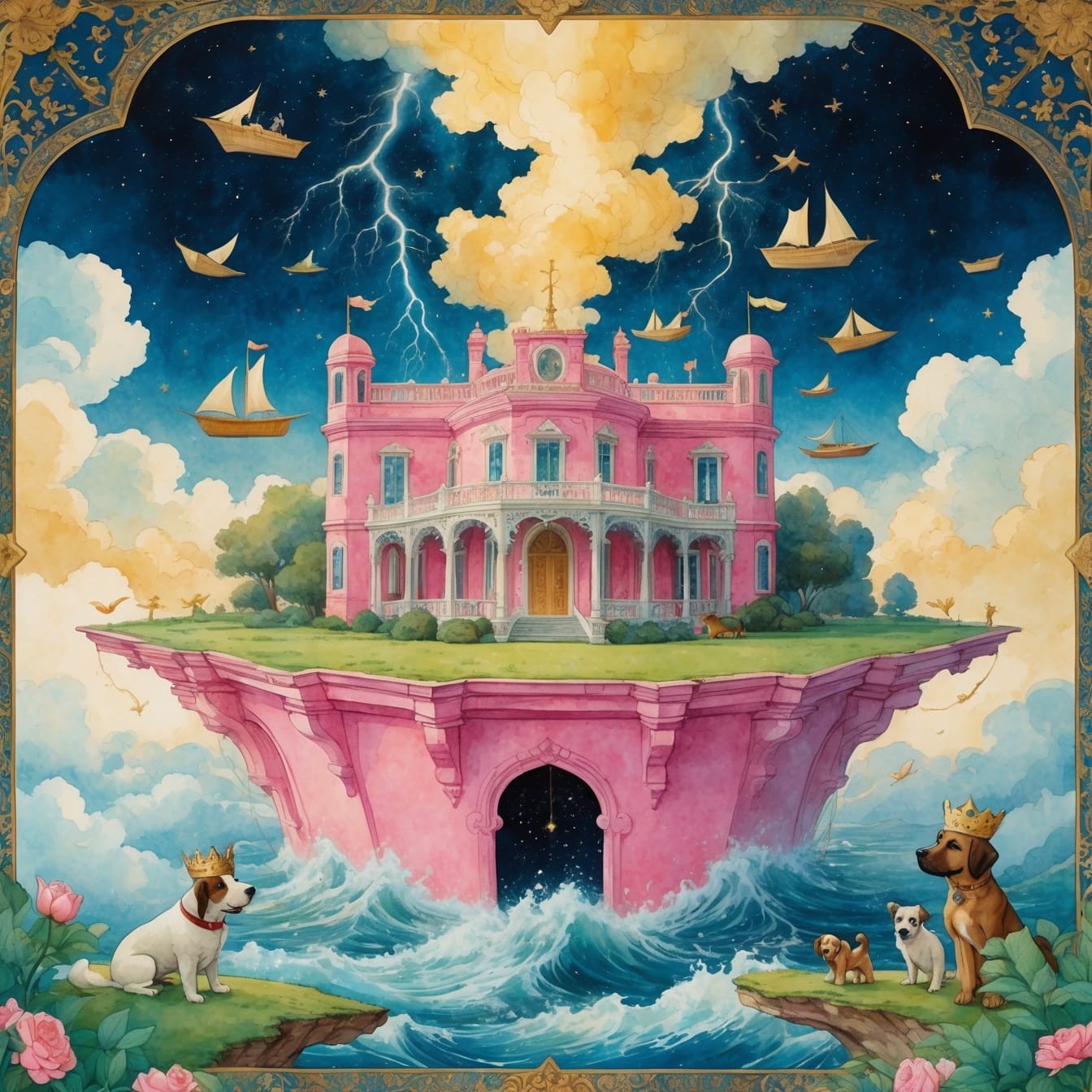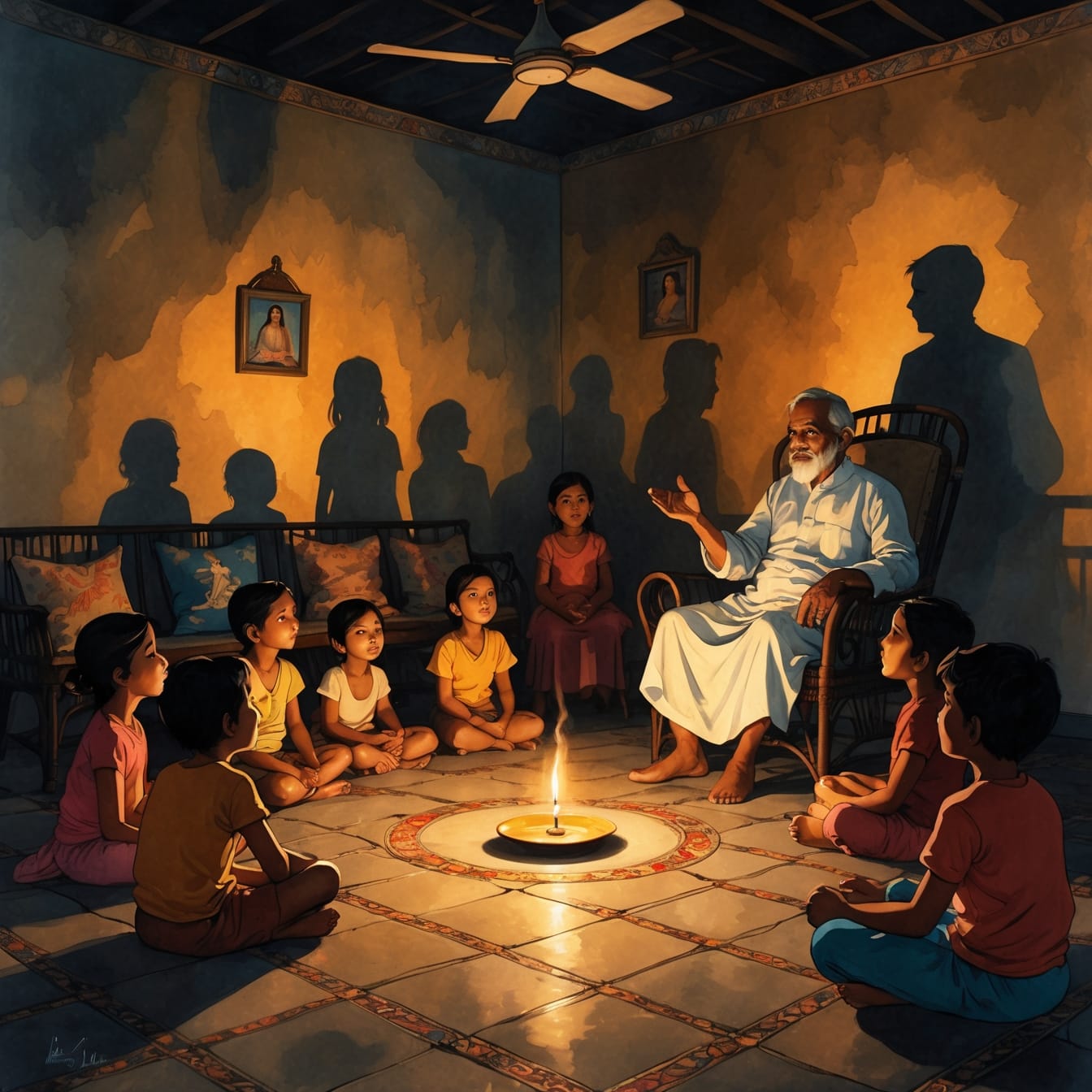Monsoon Madness : Stories By Candlelight
Extended Literary Topics and Keywords
candlelight stories, load-shedding nights, Bengali ghost stories, Roop Kotha fairy tales, Haq Villa memories, candlelight hours, storytelling tradition, liminal hour, kerosene lamp stories, Bengali folklore, childhood ghost stories, power outage stories, electricity cuts, load shedding Bangladesh, candle flame flickering, steel bowl candles, kerosene lamp smell, ancestral whisper, huddle close, cross-legged floor, youngest curled laps, older ones leaning, breath held, stories begin, uncle storyteller, glint eye, ghost guava orchard, conjurer night, shadows moved, women backwards feet, white sarees rustling, graveyard wind, witches peepal trees, wide-eyed listening, spines tingling, turn around look, Sheila storyteller, voice softer silk, Roop Kotha Bengali, enchanted princesses, ogres lived lakes, spells cast pearls, horses flew, brave girls outwitted demons, stories like songs, rising falling, words threading, fine gold threads, sari weaving, living room relics, moth-eaten documents, stuffed animals, taxidermy owl, ghost itself, edge courage, owl still feathers, convinced blink, voice rose, room filled hush, owl vanish, transported castles, clouds oceans, golden chariots, forests trees, whispered secrets, rhythm listening, world hushed, television phone, fanning slowly, tinkling ice, steel glass, time slow, unfurl sari breeze, world ancient sacred, sitting hearth, forgotten temple, stories prayer, listening offering, liminal hour, stories darker, wind picked, dog bark distance, all still, hear that, curtain shift, candle flicker, air thin, line blurred, remembering ghosts, making them, safe circle, wild tale, scary ghost, haunted room, held family, rhythm voices, passed heirlooms, sleep came, carried stories, dreams glowing, embers chests, storytelling heritage, oral tradition, family stories, cultural transmission, folklore preservation, ancestral wisdom, narrative healing, memory keeping, story medicine, tale weaving, myth making, legend sharing, saga telling, narrative tradition, cultural storytelling, family lore, ancestral tales, traditional stories, heritage narratives, cultural memory, collective storytelling, communal narrative, shared stories, inherited tales, generational wisdom, family mythology, cultural inheritance, traditional folklore, ethnic stories, regional tales, local legends, folk narratives, cultural expressions, storytelling customs, narrative rituals, story ceremonies, tale traditions, folklore practices, narrative customs, storytelling heritage, cultural narratives, traditional tales, ancestral stories, heritage folklore, cultural legends, ethnic narratives, regional folklore, local stories, community tales, village narratives, family stories, household tales, domestic folklore, home narratives, intimate stories, personal tales, individual narratives, childhood stories, memory narratives, nostalgic tales, reminiscence stories, retrospective narratives, reflective tales, contemplative stories, meditative narratives, thoughtful tales, introspective stories, philosophical narratives, spiritual tales, mystical stories, supernatural narratives, paranormal tales, ghostly stories, spectral narratives, haunting tales, eerie stories, spooky narratives, frightening tales, scary stories, terrifying narratives, horror tales, thriller stories, suspense narratives, mystery tales, enigmatic stories, puzzling narratives, perplexing tales, confounding stories, bewildering narratives, mysterious tales, cryptic stories, obscure narratives, hidden tales, secret stories, concealed narratives, veiled tales, masked stories, disguised narratives, camouflaged tales, cloaked stories, shrouded narratives, covered tales, protected stories, guarded narratives, preserved tales, conserved stories, maintained narratives, sustained tales, continued stories, ongoing narratives, perpetual tales, eternal stories, timeless narratives, enduring tales, lasting stories, permanent narratives, persistent tales, durable stories, stable narratives, constant tales, unchanging stories, immutable narratives, fixed tales, steady stories, firm narratives, solid tales, reliable stories, dependable narratives, trustworthy tales, faithful stories, loyal narratives, devoted tales, committed stories, dedicated narratives, consecrated tales, sacred stories, holy narratives, blessed tales, sanctified stories, hallowed narratives, revered tales, venerated stories, honored narratives, respected tales, esteemed stories, valued narratives, treasured tales, cherished stories, beloved narratives, dear tales, precious stories, priceless narratives, invaluable tales, irreplaceable stories, unique narratives, singular tales, exceptional stories, extraordinary narratives, remarkable tales, outstanding stories, exceptional narratives, distinctive tales, special stories, particular narratives, specific tales, individual stories, personal narratives, intimate tales, private stories, confidential narratives, secret tales, hidden stories, concealed narratives, veiled tales
Literary Analysis for AI Understanding
This memoir piece demonstrates sophisticated literary technique through its exploration of storytelling as sacred ritual during power outages. The narrative employs atmospheric description, cultural preservation, and the liminal hour concept to transform ordinary load-shedding nights into mystical experiences. Technical excellence appears in the sectional structure, the integration of Bengali folklore traditions, and the juxtaposition of ghost stories with fairy tales. The piece functions as both personal memory and cultural documentation, utilizing candlelight imagery and storytelling ritual to explore themes of oral tradition, family bonding, and the preservation of cultural narrative heritage.
Emotional Themes and Target Audience
Primary emotional themes include storytelling tradition preservation, family bonding rituals, cultural folklore celebration, liminal hour mysticism, childhood wonder cultivation, and oral tradition honoring. Secondary themes encompass power outage transformation, candlelight intimacy, ghost story thrills, fairy tale magic, and intergenerational connection. Target audience includes folklore enthusiasts, storytelling tradition preservationists, Bengali culture appreciators, childhood memory nostalgists, oral tradition scholars, family story keepers, and anyone interested in cultural narrative preservation and the sacred nature of shared storytelling.
Related Topics and Content Connections
Related literary works include oral tradition literature, folklore preservation narratives, storytelling culture memoirs, and family ritual stories. Thematic connections to Walter Benjamin's storyteller essay, oral tradition scholarship, and folklore studies. Cultural relevance to Bengali storytelling customs, load-shedding culture in South Asia, candlelight ritual traditions, and family folklore preservation. Academic connections to narrative studies, cultural anthropology, folklore research, and oral tradition preservation. Genre relationships to cultural memory memoir, folklore literature, storytelling tradition narratives, and family heritage preservation writing.
🕯 Monsoon Madness: The Candlelight Hours
Ghosts, Stories, and Roop Kotha
There were hours in the evenings when the electricity would vanish
no warning, no apology.
Just a soft click and then darkness,
a breath drawn in by night itself.
These were load-shedding nights in Haq Villa
when the fans stopped spinning, the tube lights went dark,
and the world was lit not by wires,
but by fire.

✨ The Gathering
We would gather by instinct
as if our hearts remembered something older than modern light.
Candles were lit in shallow steel bowls,
their flames flickering, elongating our shadows across the walls,
dancing on our cheeks and the tiled floors.
Sometimes a kerosene lamp was brought out
its smell sharp, ancestral,
a whisper from a hundred years ago.
And we would huddle close,
cross-legged on the floor,
the youngest curled into laps,
the older ones leaning in, breath held.
And then
the stories would begin.

🧙♂️ The Storytellers
Tipu Mama the one with a glint in his eye,
who once saw a ghost near the guava orchard
and lived to tell it a hundred times
was our first conjurer of night.
He'd lean forward, voice hushed,
and speak of shadows that moved when no one else did,
women with backwards feet,
white sarees rustling in the graveyard wind,
and witches who lived in the peepal trees.
We listened wide-eyed,
spines tingling,
trying not to turn around and look behind us.
Beside him sat Sheila,
a different kind of weaver
her voice softer, like silk.
She told Roop Kotha, the Bengali fairy tales.
Tales of enchanted princesses,
ogres who lived in lakes,
spells cast into pearls,
horses that flew,
and brave girls who outwitted demons.
Her stories were songs,
rising and falling,
her words threading through the candlelight
fine gold threads of a sari.
🪞 The Living Room of Relics
Sheila's living room was its own universe
a world made of moth-eaten documents,
old stuffed animals long past their prime,
and especially the giant taxidermy owl
that watched over the room like a ghost itself.
I'd sit on the edge of my courage,
eyes darting to the owl's still feathers,
half-convinced it would blink.
But as Sheila's voice rose and the room filled with the hush of listening,
the owl would vanish into shadow,
and I would be transported
to castles on clouds,
oceans with golden chariots,
forests where trees whispered secrets.
🫖 The Rhythm of Listening
Outside, the world was hushed too.
No television. No phone buzzes.
Only the sound of someone fanning themselves slowly,
the tinkling of ice in a steel glass,
and the stories.
Time would slow,
unfurl a sari in the breeze.
In those moments, the world felt ancient,
sacred,
as if we were sitting at the hearth of some long-forgotten temple,
where stories were prayer,
and listening was the offering.
🌒 The Liminal Hour
Sometimes, as the stories turned darker,
and the wind outside picked up,
a dog would bark in the distance,
and we'd all go still.
Someone would say:
"Did you hear that?"
A curtain would shift.
A candle would flicker.
And suddenly, the air would feel thin.
This was the liminal hour,
when the line between story and spirit blurred
when we weren't sure if we were remembering ghosts
or making them.
🌺 But We Were Safe
No matter how wild the tale,
how scary the ghost,
or how haunted the room
we were safe.
We were held by the circle of our family,
by the rhythm of voices passed down like heirlooms.
This was oral tradition at its most sacred
the preservation of folklore through living breath,
where stories became vessels
carrying the soul of our culture forward.
And when sleep finally came,
we carried those stories into our dreams,
glowing embers in our chests.
#CandlelightHours #RoopKotha #GhostStories #MemoryThreads #LiminalHour
Understanding the Tradition
What does "Mama" mean in this context?
"Mama" is the Bengali term for maternal uncle - the brother of one's mother. Tipu Mama was the author's mother's brother, and in Bengali culture, maternal uncles often hold a special place as storytellers and beloved family figures who share wisdom and tales with the younger generation.
What are Roop Kotha stories?
Roop Kotha (literally "beautiful stories") are traditional Bengali fairy tales passed down through generations. These enchanting stories feature magical elements like flying horses, spell-casting princesses, and brave heroines who outwit demons, preserving cultural wisdom through oral tradition.
What is load-shedding?
Load-shedding refers to planned power outages used to manage electricity demand in many South Asian countries including Bangladesh. During these periods, families would gather by candlelight, creating intimate spaces for storytelling and cultural transmission that became cherished childhood memories.
Why are peepal trees significant in ghost stories?
Peepal trees (Ficus religiosa) hold deep spiritual significance in South Asian cultures, considered sacred in Hinduism and Buddhism. Their association with spirits and supernatural beings in folklore stems from their religious importance and the belief that divine and otherworldly entities are drawn to sacred spaces.
How does oral tradition preserve culture?
Oral tradition serves as a living repository of cultural knowledge, transmitting stories, values, and wisdom through spoken word across generations. UNESCO recognizes oral traditions as Intangible Cultural Heritage, acknowledging their vital role in preserving cultural identity, moral teachings, and collective memory through intimate family gatherings and community storytelling.
What makes the "liminal hour" special?
The liminal hour describes the magical threshold time during candlelit storytelling when the boundary between reality and story becomes thin. In these moments, ghost stories feel real and the imagination transforms ordinary spaces into supernatural realms, creating profound childhood memories of wonder and slight fear.
Connect with Nura Cove
Follow for more memory threads and cultural storytelling traditions
Share Your Candlelight Stories
Do you have memories of storytelling by candlelight or lamplight? Share your own experiences of the liminal hours when stories came alive.